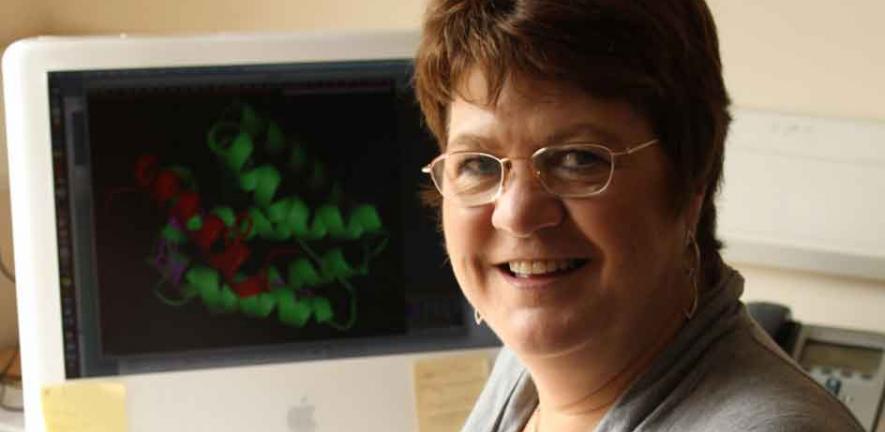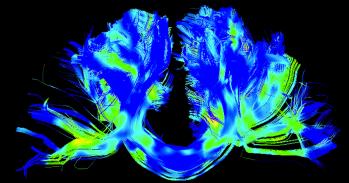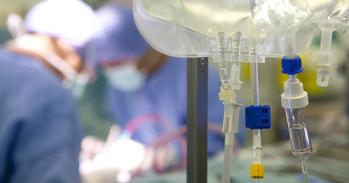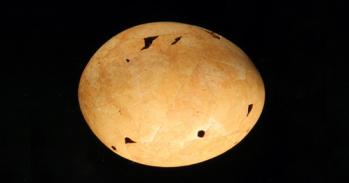
Professor Jane Clarke’s laboratory was one of the first in the world to combine atomic force microscopy with protein engineering to ‘visualise’ the mechanical unfolding of a single protein at the molecular level.
Professor Jane Clarke’s laboratory was one of the first in the world to combine atomic force microscopy with protein engineering to ‘visualise’ the mechanical unfolding of a single protein at the molecular level.
Science is at its most exciting and fun when the unexpected happens– when you get odd answers that you hadn’t predicted."
Jane Clarke
‘Proteins are remarkable – although they start life as linear strings of amino acids, encoded by the information within our genes, they have an in-built ability to fold into a precise shape,’ explains Jane Clarke, who has just been elected the Department of Chemistry’s new Professor of Molecular Biophysics. ‘It’s this three-dimensional structure that gives proteins their biological function.’
Her work focuses on the fundamental forces of physics and chemistry that determine why a protein folds in a certain way, and how one region of a protein interacts with another. Having a better understanding of this behaviour is of biomedical importance for understanding not only how proteins work but also how they lose function in certain diseases.
‘One of the things I am most excited about is investigating what’s happening at the level of individual molecules,’ says Professor Clarke, whose research is funded by the Wellcome Trust. ‘With atomic force microscopy, we use a tiny cantilever to pick up a single molecule of protein and stretch it until it unfolds, one domain at a time. By combining experiments with simulations we can predict the unfolding pathway and even design proteins with new mechanical properties.’
One protein the Clarke lab has been investigating is spectrin, which maintains the elasticity of red blood cell membranes. Her team’s latest discovery shows how mutations that cause an hereditary anaemia destroy cooperativity between the individual subunits of the spectrin protein, providing molecular understanding of precisely how mutation results in disease.
For her successes in this challenging area, she was awarded the 2010 U.S. Genomics Award for Outstanding Investigator in the Field of Single Molecule Biology.
What might others be surprised to learn about you?
I was a school teacher for almost 20 years before I even thought about doing a PhD. I liked teaching very much and was head of science in a big comprehensive school in Tottenham. My aim was to be a head teacher. The change of plan came when my husband went to work in America, where I was unqualified to teach, and I decided to go back to school and study for a Masters in Applied Biology at Georgia Institute of Technology.
Who or what inspires you?
An inspiring lecturer at Georgia Tech called Bud Suddath taught a course on protein structure – it was so fantastic that I realised this is what I wanted to work on. However, back in the UK, finding someone willing to take the chance on a 40-year-old mother-of-two wanting to do a PhD was far from easy. But Bud had given me a letter recommending me to Professor Alan Fersht here in Chemistry and Alan gave me the amazing opportunity to do a PhD in his group. As well as Bud, someone else who is a constant inspiration is my brand- new grandson – he’s both an absolute joy and a complete distraction!
Have you ever had a Eureka moment?
Science is at its most exciting and fun when the unexpected happens – when you get odd answers that you hadn’t predicted. I had a moment of inspiration when a student in my group, Sarah Batey, had some very clear results that we just couldn’t understand. We were completely stuck for nine months. One night I woke up and had the answer – I had to get up and write it down. In the morning, the mechanism still made sense, so I rushed in early and paced the lab waiting for Sarah to arrive. I still remember how excited I was! Luckily, it came at just the right minute – Sarah was able to finish her PhD and we
were able to publish.
What’s the best piece of advice you’ve ever been given?
The best advice was probably Bud’s encouragement to do a PhD. Too often the perception is that the conventional career path into research is the only one. Not only should people have the courage to try but they deserve the opportunity to succeed. Another piece of advice I’ve also always liked is Alan Fersht’s: ‘don’t waste clean thoughts on dirty data’. If the results aren’t good enough, stop wasting time trying to understand them and go and get better data!
What motivates you to go to work each day?
I love being able to work with fantastic young researchers who always bring you something new, something exciting. I have a small lab and I like it that way. It means that I can be intimately involved in the research as it’s happening. I no longer do any hands-on wet work – my group get rather distressed if I put a lab coat on – but we plan the experiments together and I see the data come out. Every day is completely different. You just don’t know what’s going to happen.
What is your favourite research tool?
My favourite research tool has to be my group – they are a wonderful mix of chemists, biochemists and physicists, all of whom bring and share their skills to tackle a challenging intellectual problem. That’s why I think research is such an inspiring career.
This work is licensed under a Creative Commons Licence. If you use this content on your site please link back to this page.





